weight HONDA CR-V 2011 RD1-RD5, RE7 / 3.G Owners Manual
[x] Cancel search | Manufacturer: HONDA, Model Year: 2011, Model line: CR-V, Model: HONDA CR-V 2011 RD1-RD5, RE7 / 3.GPages: 445, PDF Size: 8.06 MB
Page 28 of 445
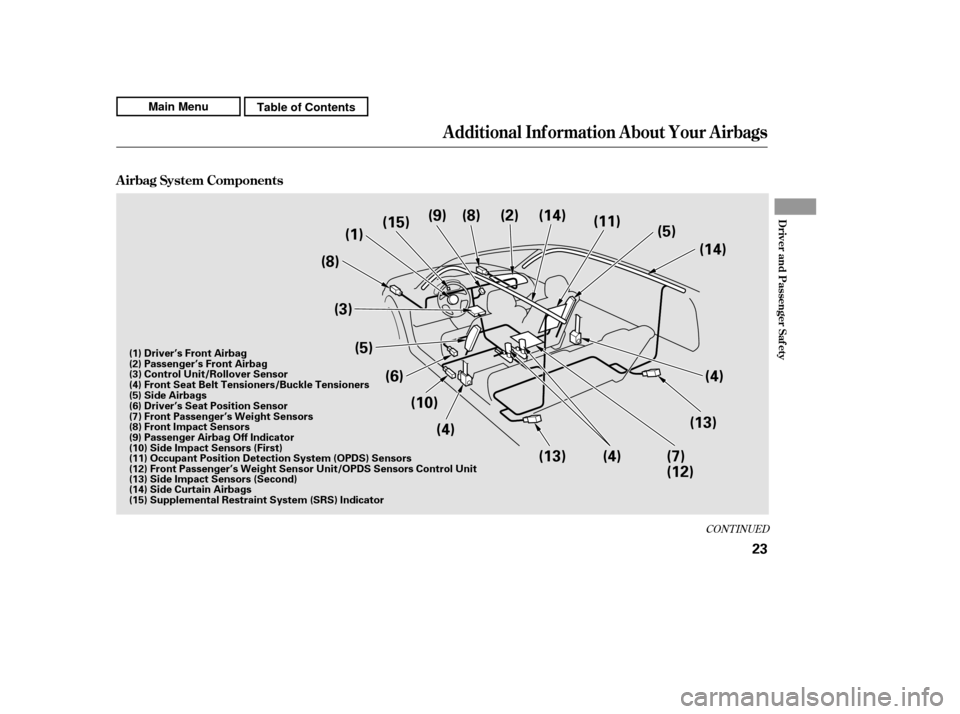
CONT INUED
A irbag System Components
Additional Inf ormation About Your Airbags
Driver and Passenger Saf ety
23
(1)(2)
(3)
(4)
(6)
(5)
(4)
(8)
(8) (14)
(10) (13)
(4)
(7)
(12)
(15)
(9)
(11)
(5)
(14)
(13)
(1) Driver’s Front Airbag
(2) Passenger’s Front Airbag
(3) Control Unit/Rollover Sensor
(4) Front Seat Belt Tensioners/Buckle Tensioners
(5) Side Airbags
(6) Driver’s Seat Position Sensor
(7) Front Passenger’s Weight Sensors
(8) Front Impact Sensors
(9) Passenger Airbag Off Indicator
(10) Side Impact Sensors (First)
(11) Occupant Position Detection System (OPDS) Sensors
(12) Front Passenger’s Weight Sensor Unit/OPDS Sensors Control Unit
(13) Side Impact Sensors (Second)
(14) Side Curtain Airbags
(15) Supplemental Restraint System (
SRS) Indicator
Main MenuTable of Contents
Page 29 of 445

Your airbag system includes:Two SRS (supplemental restraint
system) f ront airbags. The driver’s
airbag is stored in the center of
the steering wheel; the f ront
passenger’sairbagisstoredinthe
dashboard. Both are marked ‘‘SRS
AIRBAG’’ (see page ).
Two side airbags, one f or the
driver and one f or a f ront
passenger. The airbags are stored
in the outer edges of the seat-
backs. Both are marked ‘‘SIDE
AIRBAG’’ (see page ).
Two side curtain airbags, one f or
each side of the vehicle. The
airbags are stored in the ceiling,
above the side windows. The f ront
and rear pillars are marked ‘‘SIDE
CURTAIN AIRBAG’’ (see page ). Automatic front seat belt
tensioners (see page ).
Sensors that can detect a
moderate to severe front impact,
side impact, or if your vehicle is
about to rollover.
Sensors that can detect whether a
child is in the passenger’s side
airbag path and signal the control
unit to turn the airbag of f (see
page ).
A driver’s seat position sensor that
monitors the distance of the seat
from the front airbag. If the seat is
too f ar f orward, the airbag will
inf late with less f orce (see page
). Weight sensors that monitor the
weight on the f ront passenger’s
seat. If the weight is about 65 lbs
(29 kg) or less (the weight of an
inf ant or small child), the
passenger’s f ront airbag will be
turned of f (see page ).
Sensors that can detect whether
the driver’s seat belt and the f ront
passenger’s seat belt are latched
or unlatched (see page ).
A sophisticated electronic system
that continually monitors and
records inf ormation about the
sensors, the control unit, the
airbag activators, the seat belt
tensioners, and driver and f ront
passenger seat belt use when the
ignition switch is in the ON (II)
position.
31 29
25 21
30
28 28
19
Additional Inf ormation About Your Airbags
24
Main MenuTable of Contents
Page 33 of 445
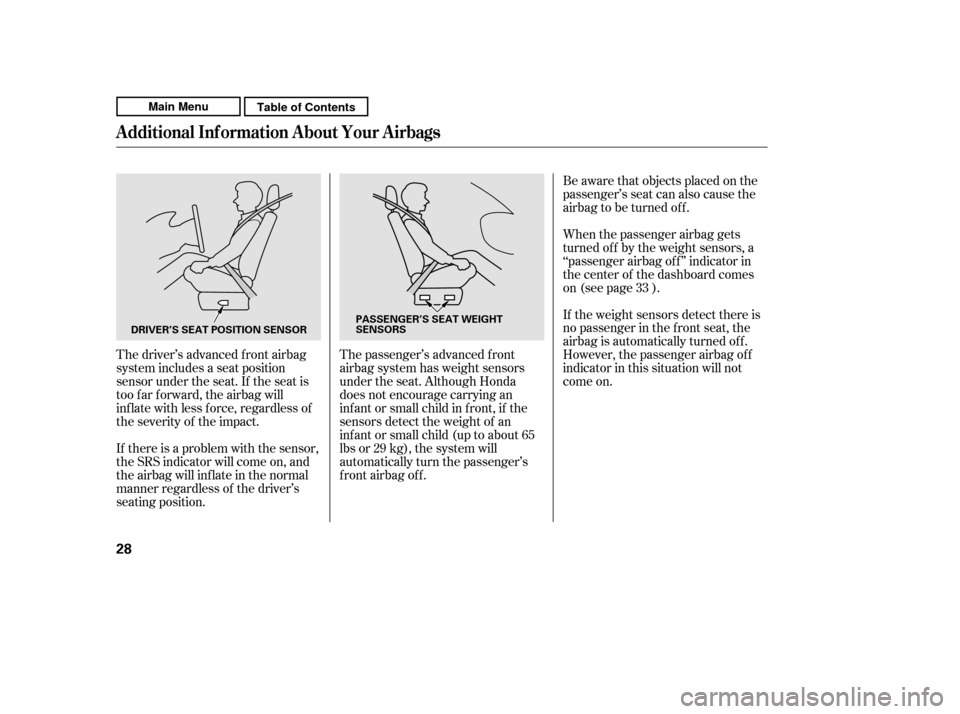
The driver’s advanced front airbag
system includes a seat position
sensor under the seat. If the seat is
too f ar f orward, the airbag will
inf late with less f orce, regardless of
the severity of the impact.
If there is a problem with the sensor,
the SRS indicator will come on, and
the airbag will inf late in the normal
manner regardless of the driver’s
seating position.The passenger’s advanced f ront
airbag system has weight sensors
under the seat. Although Honda
does not encourage carrying an
inf ant or small child in f ront, if the
sensors detect the weight of an
inf ant or small child (up to about 65
lbs or 29 kg), the system will
automatically turn the passenger’s
front airbag off.Be aware that objects placed on the
passenger’s seat can also cause the
airbag to be turned of f .
When the passenger airbag gets
turned of f by the weight sensors, a
‘‘passenger airbag of f ’’ indicator in
the center of the dashboard comes
on (see page ).
If the weight sensors detect there is
no passenger in the f ront seat, the
airbag is automatically turned off.
However, the passenger airbag of f
indicator in this situation will not
come on.
33
Additional Inf ormation About Your Airbags
28
DRIVER’S SEAT POSITION SENSOR
PASSENGER’S SEAT WEIGHT
SENSORS
Main MenuTable of Contents
Page 34 of 445
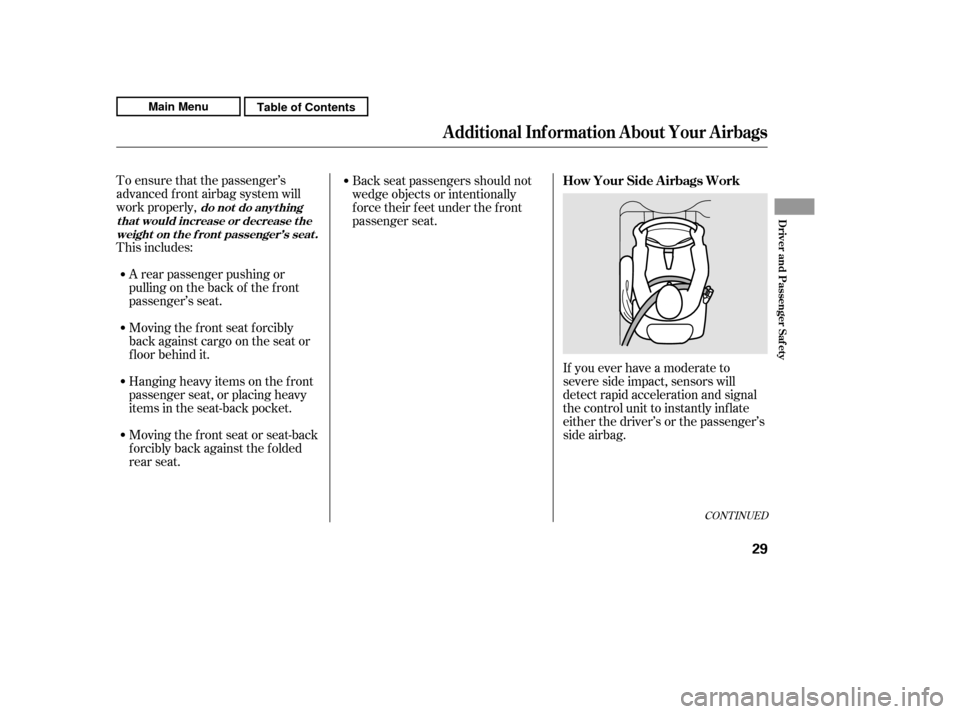
CONT INUED
To ensure that the passenger’s
advanced front airbag system will
work properly,
This includes:A rear passenger pushing or
pulling on the back of the f ront
passenger’s seat.
Moving the f ront seat f orcibly
back against cargo on the seat or
f loor behind it.
Hanging heavy items on the f ront
passenger seat, or placing heavy
items in the seat-back pocket.
Moving the front seat or seat-back
f orcibly back against the f olded
rear seat. Back seat passengers should not
wedge objects or intentionally
f orce their f eet under the f ront
passenger seat.
If you ever have a moderate to
severe side impact, sensors will
detect rapid acceleration and signal
the control unit to instantly inf late
either the driver’s or the passenger’s
side airbag.
How Your Side A irbags Work
Additional Inf ormation About Your Airbags
do not do anyt hing
t hat would increase or decrease t he
weight on the f ront passenger’s seat.Driver and Passenger Saf ety
29
Main MenuTable of Contents
Page 38 of 445

This indicator alerts you that the
passenger’s f ront airbag has been
shut of f because weight sensors
detect about 65 lbs (29 kg) or less
(the weight of an inf ant or small
child) on the f ront passenger’s seat.
It does there is a problem
with the airbag.Be aware that objects placed on the
f ront seat can cause the indicator to
come on.
If no weight is detected on the f ront
seat, the airbag will be automatically
shut of f . However, the indicator will
not come on.
The passenger airbag of f indicator
maycomeonandoff repeatedlyif
the total weight on the seat is near
the airbag cutof f threshold.
If the indicator comes on with no
f ront seat passenger and no objects
on the seat, or with an adult riding
there, something may be interf ering
with the weight sensors. Look f or
and remove:
Any items under the f ront
passenger’s seat.
Any object(s), such as a f olded-
down back seat, that are touching
the rear of the seat-back.
If no obstructions are f ound, have
your vehicle checked by a dealer as
soon as possible.
If an adult or teenage passenger is
riding in f ront, move the seat as f ar
to the rear as possible, and have the
passenger sit upright and wear the
seat belt properly. Any object(s) hanging on the seat
or in the seat-back pocket.
How the Passenger Airbag Of f
Indicator Works
not mean
Additional Inf ormation About Your Airbags
Driver and Passenger Saf ety
33
Canada
U.S.
PASSENGER
AIRBAG OFF
INDICATOR
Main MenuTable of Contents
Page 39 of 445

If water or
another liquid soaks into a seat-
back, it can prevent the side airbag
cutof f system f rom working
properly.
Tampering could cause
the airbags to deploy, possibly
causing very serious injury. Together, airbags and
seat belts provide the best
protection. Even if your
airbags do not inflate, your dealer
should inspect the driver’s seat
position sensor, the f ront
passenger’s weight sensors, the
f ront seat belt tensioners, and all
seat belts and their anchors worn
during a crash to make sure they
are operating properly.
Your airbag systems are virtually
maintenance f ree, and there are no
parts you can saf ely service.
However, you must have your
vehicle serviced if:
Any airbag
that has deployed must be
replaced along with the control
unit and other related parts. Any
seat belt tensioner that activates
must also be replaced.
Do not try to remove or replace
anyairbagbyyourself.Thismust
be done by an authorized dealer or
a knowledgeable body shop.
Take your vehicle to an
authorized dealer as soon as
possible. If you ignore this
indication, your airbags may not
operate properly. This could make the
driver’s seat position sensor or the
f ront passenger’s weight sensors
inef f ective. If it is necessary to
remove or modif y a f ront seat to
accommodate a person with
disabilities, f irst contact Honda
Automobile Customer Service at
(800) 999-1009 in the US, or
Honda Customer Relations at 1-
888-9-HONDA-9 in Canada.
Do not expose t he f ront passenger’s
seat-back to liquid.
Do not t amper wit h airbag component s or wiring f or any reason.
Donotattempttodeactivateyour
airbags.
If your vehicle has a moderat e t o
severe impact .
An airbag ever inf lates.
T he SRS indicat or alert s you t o aproblem. Do not remove or modif y a f ront
seat without consulting your
dealer.
Additional Saf ety Precautions
Airbag Service
Additional Inf ormation About Your Airbags
34
Main MenuTable of Contents
Page 45 of 445
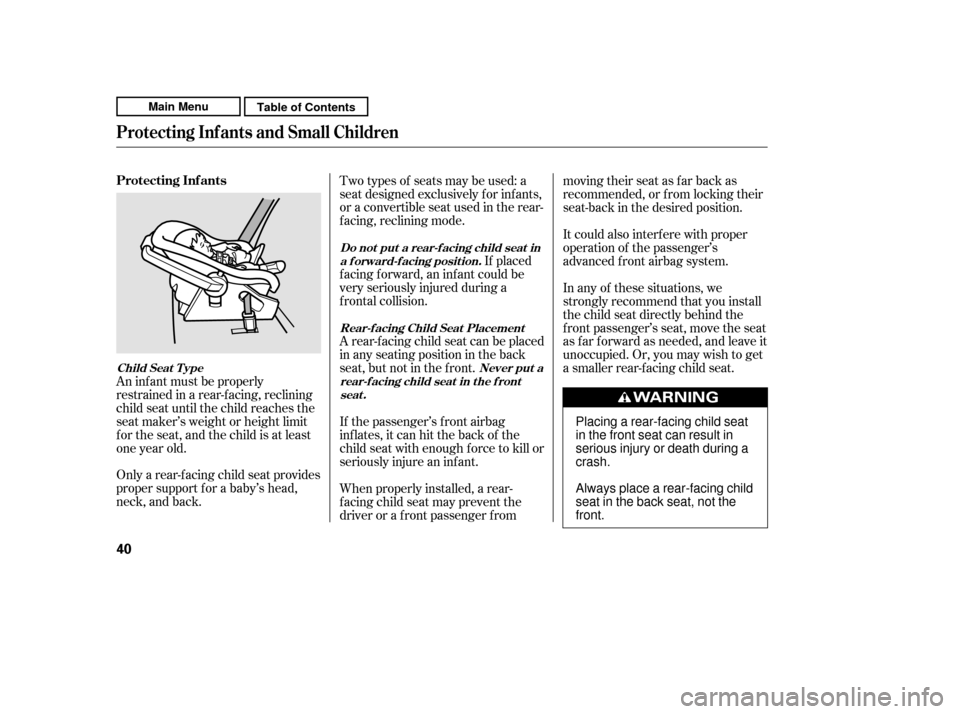
Only a rear-f acing child seat provides
proper support f or a baby’s head,
neck, and back.
An inf ant must be properly
restrained in a rear-f acing, reclining
child seat until the child reaches the
seat maker’s weight or height limit
f or the seat, and the child is at least
one year old. Two types of seats may be used: a
seat designed exclusively f or inf ants,
or a convertible seat used in the rear-
f acing, reclining mode.
If placed
f acing f orward, an inf ant could be
very seriously injured during a
f rontal collision.
A rear-f acing child seat can be placed
in any seating position in the back
seat, but not in the f ront.
If the passenger’s front airbag
inflates, it can hit the back of the
child seat with enough f orce to kill or
seriously injure an inf ant.
When properly installed, a rear-
f acing child seat may prevent the
driver or a f ront passenger f rom moving their seat as far back as
recommended, or f rom locking their
seat-back in the desired position.
It could also interf ere with proper
operation of the passenger’s
advanced front airbag system.
In any of these situations, we
strongly recommend that you install
the child seat directly behind the
f ront passenger’s seat, move the seat
as far forward as needed, and leave it
unoccupied. Or, you may wish to get
a smaller rear-f acing child seat.
Do not put a rear-f acing child seat in
a f orward-f acing position.
Child Seat T ype Rear-f acing Child Seat Placement
Never put a
rear-f acing child seat in t he f ront
seat .
Protecting Inf ants
Protecting Inf ants and Small Children
40
Placing a rear-facing child seat
in the front seat can result in
serious injury or death during a
crash.
Always place a rear-facing child
seat in the back seat, not thefront.
Main MenuTable of Contents
Page 46 of 445
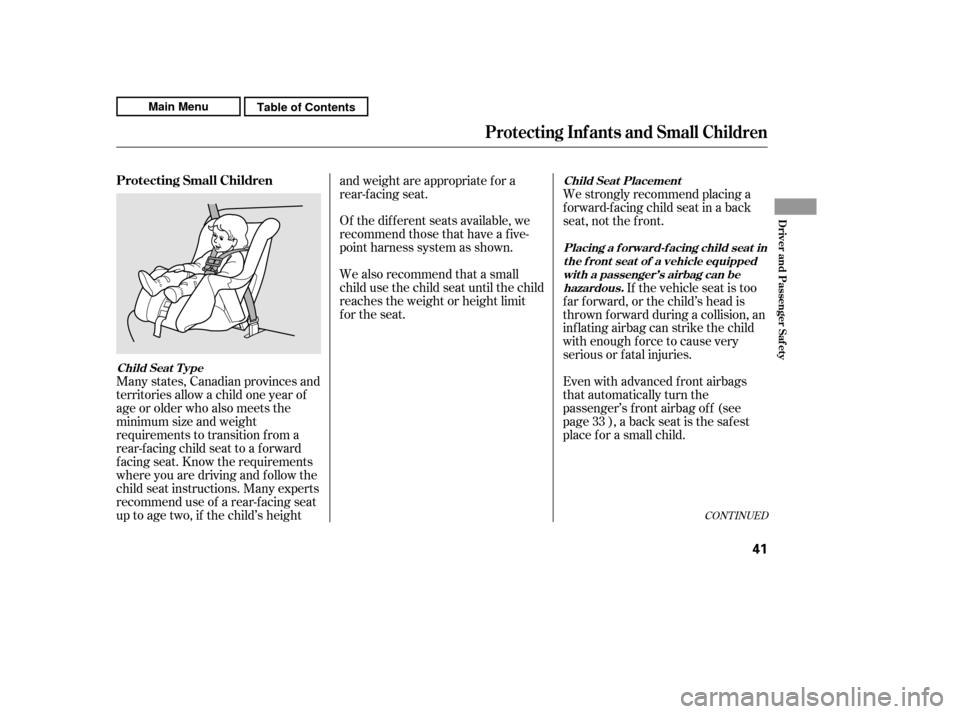
CONT INUED
Many states, Canadian provinces and
territories allow a child one year of
age or older who also meets the
minimum size and weight
requirements to transition f rom a
rear-f acing child seat to a f orward
f acing seat. Know the requirements
where you are driving and f ollow the
child seat instructions. Many experts
recommend use of a rear-f acing seat
up to age two, if the child’s heightand weight are appropriate f or a
rear-f acing seat.
Of the different seats available, we
recommend those that have a f ive-
point harness system as shown.
We also recommend that a small
child use the child seat until the child
reaches the weight or height limit
for the seat.
We strongly recommend placing a
forward-facing child seat in a back
seat, not the f ront.
Even with advanced front airbags
that automatically turn the
passenger’s front airbag off (see
page ), a back seat is the saf est
place f or a small child.If the vehicle seat is too
f ar f orward, or the child’s head is
thrown f orward during a collision, an
inf lating airbag can strike the child
with enough f orce to cause very
serious or f atal injuries.
33
Protecting Inf ants and Small Children
Protecting Small Children
Child Seat T ype Child Seat Placement
Placing a f orward-f acing child seat int he f ront seat of a vehicle equipped
with a passenger’s airbag can behazardous.
Driver and Passenger Saf ety
41
Main MenuTable of Contents
Page 53 of 445
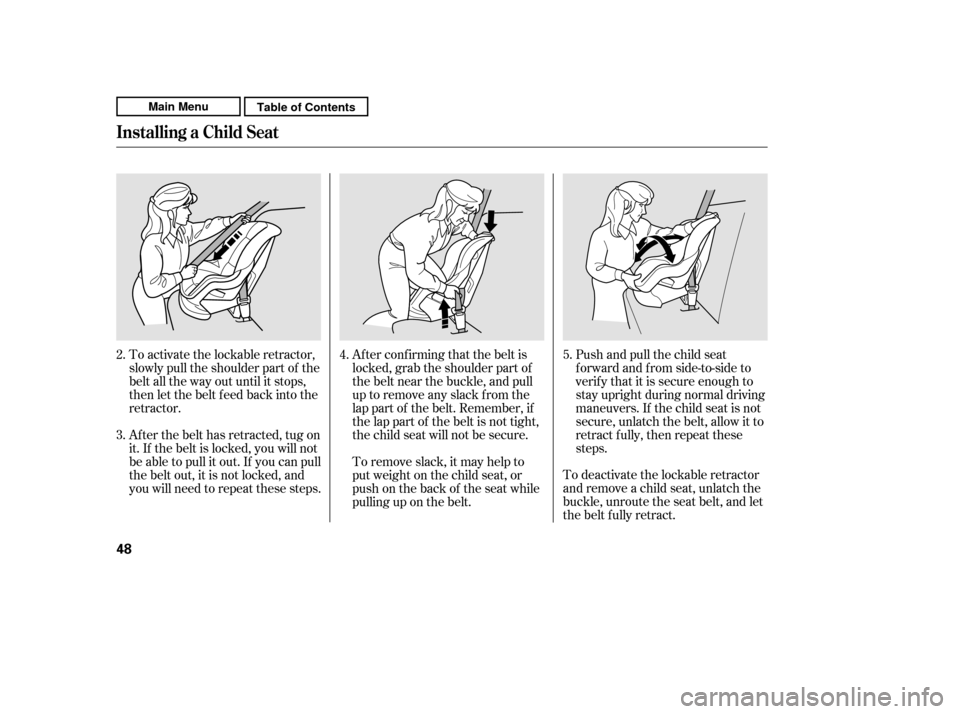
To deactivate the lockable retractor
and remove a child seat, unlatch the
buckle, unroute the seat belt, and let
the belt fully retract.Push and pull the child seat
f orward and f rom side-to-side to
verif y that it is secure enough to
stay upright during normal driving
maneuvers. If the child seat is not
secure, unlatch the belt, allow it to
retract f ully, then repeat these
steps.
Af ter conf irming that the belt is
locked, grab the shoulder part of
the belt near the buckle, and pull
up to remove any slack from the
lap part of the belt. Remember, if
the lap part of the belt is not tight,
the child seat will not be secure.
To remove slack, it may help to
putweightonthechildseat,or
push on the back of the seat while
pulling up on the belt.
To activate the lockable retractor,
slowly pull the shoulder part of the
belt all the way out until it stops,
then let the belt f eed back into the
retractor.
Af ter the belt has retracted, tug on
it. If the belt is locked, you will not
be able to pull it out. If you can pull
thebeltout,itisnotlocked,and
you will need to repeat these steps.
4.
5.
2. 3.
Inst alling a Child Seat
48
Main MenuTable of Contents
Page 56 of 445
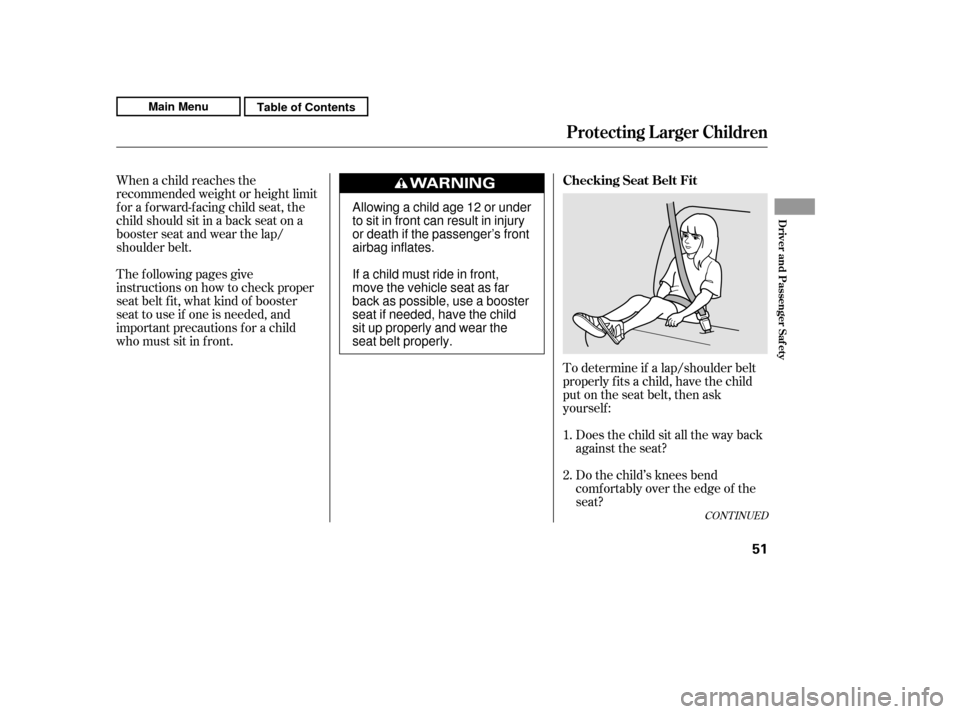
When a child reaches the
recommended weight or height limit
for a forward-facing child seat, the
child should sit in a back seat on a
booster seat and wear the lap/
shoulder belt.
The f ollowing pages give
instructions on how to check proper
seat belt f it, what kind of booster
seat to use if one is needed, and
important precautions f or a child
who must sit in f ront.To determine if a lap/shoulder belt
properly f its a child, have the child
put on the seat belt, then ask
yourself :Does the child sit all the way back
against the seat?
Do the child’s knees bend
comf ortably over the edge of the
seat?
1. 2.
CONT INUED
Checking Seat Belt Fit
Protecting L arger Children
Driver and Passenger Saf ety
51
Allowing a child age 12 or under
to sit in front can result in injury
or death if the passenger’s front
airbag inflates.
If a child must ride in front,
move the vehicle seat as far
back as possible, use a booster
seat if needed, have the child
sit up properly and wear the
seat belt properly.
Main MenuTable of Contents